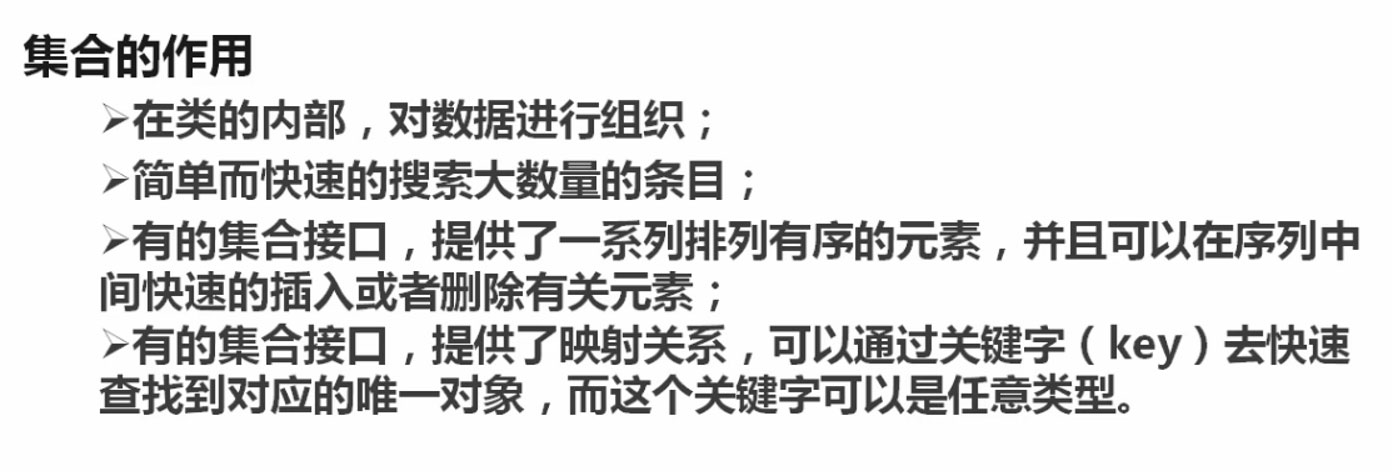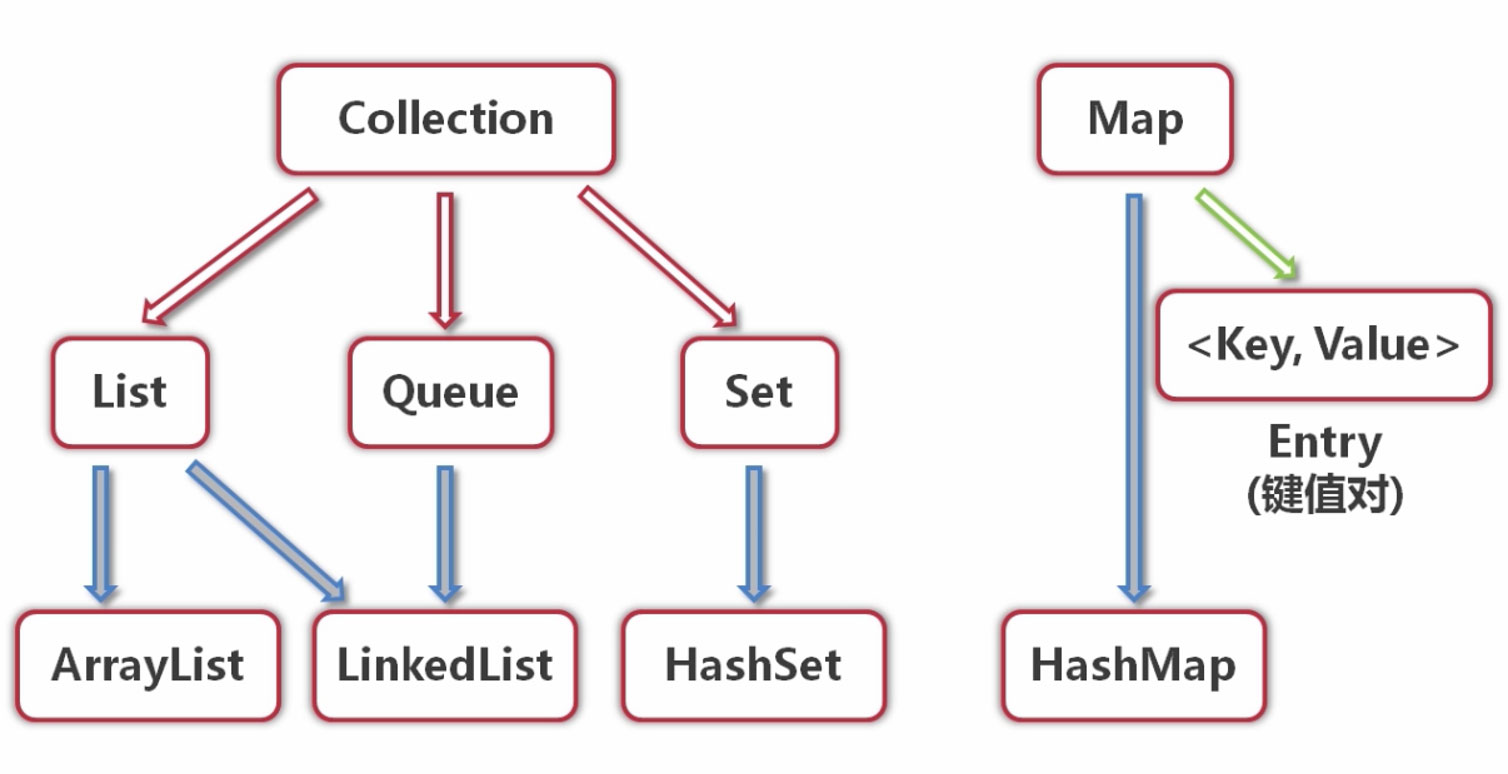概念
java中的集合类:是一种工具类,就像是容器,储存任意数量的具有共同属性的对象
集合的作用


集合框架的类型:
collection和map 都是接口,不能实例化
list和queue有序、可重复,set无序、不可重复

list添加元素两种add方法
1、直接添加,元素添加在队尾;
对象存入集合都变成object类型,取出时需要类型转换
2、指定位置添加,指定的位置(从0开始)不能超过队列的长度,否则报错(数组下标越界)。
list的两种addall方法:添加类的数组
|
1
2
3
4
5
6
7
8
9
10
11
12
13
14
15
16
17
18
19
20
21
22
23
24
25
26
|
public void testadd(){ //add方法一 course cr1 = new course("1", "课程一"); coursestoselect.add(cr1); course temp = (course)coursestoselect.get(0); system.out.println("添加了课程:"+temp.id+":"+temp.name); //add方法二,添加到指定位置 course cr2 = new course("2", "课程二"); coursestoselect.add(0, cr2);; course temp2 = (course)coursestoselect.get(0); system.out.println("添加了课程:"+temp2.id+":"+temp2.name); //addall数组添加方法一 course[] cr34 = {new course("3", "课程三"), new course("4", "课程四")}; coursestoselect.addall(arrays.aslist(cr34));//添加数组的方法 course temp3 = (course)coursestoselect.get(2); course temp4 = (course)coursestoselect.get(3); system.out.println("添加了两门课程:"+temp3.id+":"+temp3.name+ ";"+temp4.id+":"+temp4.name); //addall数组添加方法二,添加到指定位置 course[] cr56 = {new course("5", "课程五"), new course("6", "课程六")}; coursestoselect.addall(2, arrays.aslist(cr56)); course temp5 = (course)coursestoselect.get(2); course temp6 = (course)coursestoselect.get(3); system.out.println("添加了两门课程:"+temp5.id+":"+temp5.name+ ";"+temp6.id+":"+temp6.name); } |
遍历list
1.for循环遍历
|
1
2
3
4
5
6
7
8
9
10
11
12
|
/** * 取得list中的元素的方法 * @param args */ public void testget(){ int size = coursestoselect.size(); system.out.println("有如下课程待选:"); for(int i=0; i<size;i++){ course cr = (course)coursestoselect.get(i); system.out.println("课程:"+cr.id+":"+cr.name); } } |
2.通过迭代器来遍历list,迭代器只是用来遍历集合中元素的,本身不具有存储元素的功能。可以说它是依赖某个集合存在的,不能独立存在。
|
1
2
3
4
5
6
7
8
9
10
11
12
|
/** * 通过迭代器来遍历list * @param args */ public void testiterator(){ iterator it = coursestoselect.iterator(); system.out.println("有如下课程待选(迭代器):"); while(it.hasnext()){ course cr = (course)it.next();//iterator的next方法 system.out.println("课程:"+cr.id+":"+cr.name); } } |
3.通过for each 方法访问集合元素
|
1
2
3
4
5
6
7
8
9
10
11
|
/** * 通过for each 方法访问集合元素 * @param args */ public void testforeach(){ system.out.println("有如下课程待选(for each):"); for(object obj:coursestoselect){ course cr = (course)obj;//取出的元素一致都为object类型,需要强转 system.out.println("课程:"+cr.id+":"+cr.name); } } |
修改list中的元素。list中有个set方法
|
1
2
3
4
5
6
7
|
/** * 修改list中的元素 * @param args */ public void testmodify(){ coursestoselect.set(4, new course("7", "课程七")); } |
删除list中的元素。与add相似,有remove和removeall两种
|
1
2
3
4
5
6
7
8
9
10
11
|
/** * 删除list中的元素 * @param args */ public void testremore(){ course cr = (course)coursestoselect.get(4); system.out.println("我是课程:"+cr.id+":"+cr.name+",我即将被删除了"); coursestoselect.remove(cr); system.out.println("删掉了。。"); testforeach();//方法内部调用方法 } |
上述remove()中也可直接放入索引下标,即可直接删除。如remove(4)
removeall是从一个集合中将另一个集合中的所有元素全部删除。
|
1
2
3
4
5
6
7
|
public void testremore(){ course[] courses={(course)coursestoselect.get(3),(course)coursestoselect.get(4)}; system.out.println("我是课程:3,4,我即将被删除了"); coursestoselect.removeall(arrays.aslist(courses)); system.out.println("删掉了。。"); testforeach();//方法内部调用方法 } |
**实际编写代码中最好每个类中的属性都私有(private),需要使用时再用getxx或setxx
|
1
2
3
4
5
6
7
|
private string id;public string getid(){ return id;}public string setid(){ this.id=id;} |
以上就是本文的全部内容,希望本文的内容对大家的学习或者工作能带来一定的帮助,同时也希望多多支持服务器之家!
原文链接:http://www.cnblogs.com/atingjia/p/6479888.html

















